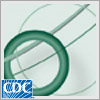Taking Care of Your New Arm or Leg After an Amputation
[Announcer] This podcast is presented by the Centers for Disease Control and Prevention. CDC - safer, healthier people.
It is important to learn how to take care of your new arm or leg after an amputation. Your new arm or leg is called a prosthesis. If you don't take care of it properly, the new arm or leg won't work like you want it to or it may hurt. The arm or leg that's left on your body is called the residual limb. It will be put inside a socket or liner of the new arm or leg. Sometimes the residual limb can hurt or get germs in it. Here are some ways to take care of yourself:
• Wash anything that touches the skin of your residual limb, such as liners, socks, or an inner socket, with mild soap and clean water, then rinse and dry. Do not use a wet liner, sock, or other cloth.
• Don't put lotion or oil on your residual limb right before putting on the prosthesis.
• Make sure your prosthesis fits well. Learn how to fix your sock, if you have one, and get help if your skin gets red or sore.
• Wear the same shoes that you wear regularly when your new leg is fitted. Try to wear these shoes with the new leg so you can walk straight and not limp.
• If your arm or leg feels funny when you have the prosthesis on, you might need to have it checked.
• Swelling stretches the skin and makes it easier to break or tear. To help prevent swelling of your residual limb, keep a bandage or cloth on it, raise it above your chest, if you can, and try to rest.
• If you have a prosthesis and diabetes, try to take good care of yourself. Diabetes is when you have high sugar, or glucose, in your blood. It is important to follow the instructions of your doctor or nurse to keep your sugar levels normal.
• Watch closely for redness or soreness. This is very important if your blood does not flow to your legs very well. Every day, have someone look at the parts of your leg that you can’t see for redness or sores. Sores, blisters, or bubbles on your skin, and infections may happen, even if you're careful.
Here are some things that might happen and tips for how to deal with them:
• If your skin is red and the redness doesn't go away when the prosthesis is off, get it checked and don't wear it again until the redness is gone.
• If you get blisters or bubbles on your skin, be careful. Do not burst or pop the blister. Cover it with something clean, like a cloth. If the blister pops by itself, keep it clean and covered and try to get medical help.
• If the skin itches, gets red bumps, or a rash, you may need to stop wearing the prosthesis until it goes away. Try to see a doctor or nurse to get a special cream. If it burns keep the arm or leg very dry and let air get to it.
• If you have thick red bumps on the end of the limb, get it checked. You may need to have the bumps removed.
For more information about how to take care of yourself after an amputation or other surgery, please visit www.cdc.gov and search on “amputees” or www.amputee-coalition.org.
[Announcer]For the most accurate health information, visit www.cdc.gov or call 1-800-CDC-INFO, 24/7.



